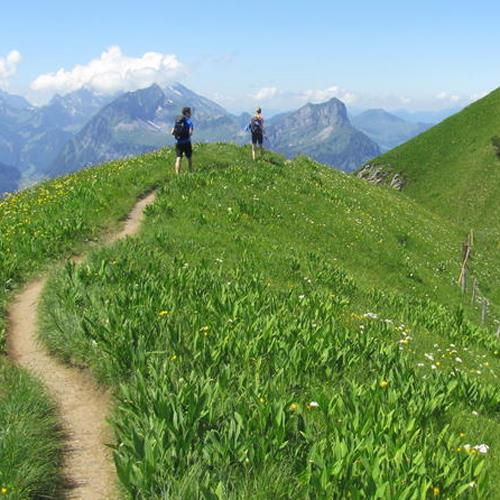EXPERIENCE ALSACE LORRAINE - MOSELLE RIVER VALLEY


Overview
Moselle flows through France’s Lorraine Region (western part of the department and is the emblematic river of Alsace), to Luxembourg and through Germany, flanked by rolling hills covered in vineyards and crowned with castles. The river valley has changed hands over the centuries, from French control, to German, and back again. Battles were won and lost, monuments built, and artistic masterpieces created.
The Moselle’s source is in the Vosges Mountains at a height of more than 2,400 feet above sea level. Downstream, the river has formed the Moselle Valley between the Eifel and Hunsrück mountain regions. The entire river is approximately 340 miles in length from source to mouth. For a long stretch, it forms the border between Germany and Luxembourg. It is the longest tributary of the Rhine River, joining it at Koblenz. The Moselle Valley is an industrial area, with coal mining and steel manufacturing, and can accommodate large cargo ships. Developing the river into a navigable waterway was completed in 1964 in accordance with an agreement signed by Germany, Luxembourg and France. The river now carries much traffic in addition to cruise vessels and has 14 sets of locks and a shipping channel. Though the area is largely industrial, the Valley is also known for its beautiful scenery; the Moselle’s German portion features castles and vine-covered hillsides; grapes grown between Trier and Koblenze are used to make Moselle wine.



Things to See and Do
Moselle Wine Route: The Moselle winegrowing region lies along the Moselle with a cultivated area of over 25,000 acres. The route stretches for 150-mile along the river, the largest part is on German soil in the states of Rhineland-Palatinate and Saarland. Upstream on the Moselle the vineyards extend into France as far as Seille in the region of Cotes de Moselle and ot the region around Toul. The route is doubled by the Moselle cycle path which departs from Metz.
The wine route boasts world-class vintages and even a 4th-century Roman wine press which indicates that the Moselle Valley is Germany’s oldest winegrowing region. This region has been considered the best place for Riesling in the world, though you can also find exceptional Pinot Blanc, Pino Gris, Elbling, Müller-Thurgau and even some Chardonnay and Pinot Noir.
Moselle Cycleway: This path may be cycled from Metz in France via Trier to Koblenz on the River Rhine, a distance of 193 miles. Between Koblenz and Trier, large sections run on the trackbed of the old Moselle Valley Railway, far from the noise and fumes of motor vehicles.
The Moselle Ridgeway: Established in 1910, the ridgeway runs for 115-miles on the Eifel side and 163-miles on the Hunsruck side. Another unusual trail runs from Ediger-Eller via the Calmont Trail to Bremm through the steepest vineyard in Europe.
Hiking: Take a hike in the Moselle River Valley with fabulous trails that are well-maintained with beautiful views along the way. The ever-changing landscapes are marked by a succession of old castles on the slopes of the valley and in the surrounding side valleys, and by a string of charming little towns and villages. Combined with stopping in the renowned vineyards this is an unforgettable way to discover the region.
Castles: A visit to a castle, whether you stumble over one during a hike outdoors or walk your way around the grounds with a guide, is always something special, and you’ve got 20 beautiful castles to choose from in the Moselle Valley.
The Moselle Loop: The giant loop near Toul is a distinctive feature of the river. This is explained by a hydrographic phenomenon: the ‘capture’ of the Moselle. Thousands of years ago, the river continued through Pagny-sur-Meuse and joined the Meuse river. Then the Moselle changed its course by turning away from its original course. It turned to the east and followed the course of a stream which flowed into the Meurthe near Frouard. In doing so, it crosses the foot of the current Côtes de Moselle.

Towns
Towns along the Moselle are:
- In France: Épinal, Toul, Pont-à-Mousson, Metz and Thionville
- In Luxembourg: Schengen, Remich, Grevenmacher and Wasserbillig
- In Germany: Konz, Trier, Schweich, Bernkastel-Kues, Traben-Trarbach, Zell, Cochem and Koblenz

Wine
Excellent wines are produced in the Moselle River regions of Germany, Luxembourg and France, most notably Riesling, Elbling, Müller-Thurgau, Kerner and Auxerrois. The warm climate and high levels of sunshine in the river regions are particularly favorable for growing grapes, and wine has been made here for centuries. Probably even before the arrival of the Romans, wine was made from grapes picked from wild vines. When the Romans conquered the area around the river they brought with them cultivated vines from Italy. Aristocrats and monks founded vineyards here during the Middle Ages, and many of these vineyards still exist. Today, wines from the river region are mainly marketed by the vintners themselves, and nearly every village along the river has a wine festival. Sampling these wines is a favorite experience for many visitors.

History
The Moselle was known to the Romans by the name of Flumen Musalla, and the river was romanticized by the poet Ausonius around 371. From 1815, the Moselle formed the border between the Grand Duchy of Luxembourg and Prussia (German Empire in 1871).
In the act of April 10, 1952 ratifying the treaty instituted by the ECSC, Article 2 charged the French Government "to initiate, before the establishment of the Common Market, negotiations with the governments concerned in order to achieve a rapid implementation of the canalization of the Moselle between Thionville and Koblenz.
The River was canalized between Metz and Thionville, via a canal opened in 1964 by the Grand Duchess, Charlotte of Luxembourg, the Federal Chancellor of Germany, Konrad Adenauer and their host, Charles de Gaulle, President of France.
It is on the Moselle, at the site of the France–Germany–Luxembourg tripoint, that the Schengen Agreement was signed in 1992, establishing the free movement of goods and people in the European Community.